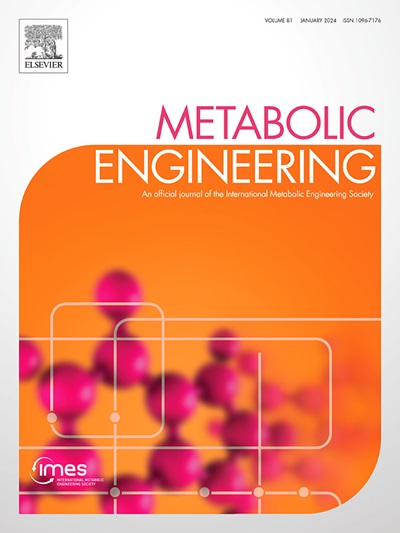Metabolic engineering in Hot Acid: Strategies enabling chemolithotrophy in thermoacidophilic archaea
IF 6.8
1区 生物学
Q1 BIOTECHNOLOGY & APPLIED MICROBIOLOGY
引用次数: 0
Abstract
A genome-scale metabolic model was developed to explore metabolic engineering strategies for thermoacidophilic archaea, with a focus on the genetically tractable Sulfolobus acidocaldarius (Topt 75 °C, pHopt 2.5). S. acidocaldarius is natively neither an autotroph nor a sulfur oxidizer, although its genome suggests that this might have been the case at some evolutionary point. Comparative genomics provided insights into key genes and pathways missing from S. acidocaldarius necessary for chemolithotrophy. Growth data for the chemolithotrophic sulfur oxidizer, Sulfurisphaera ohwakuensis (Topt 85 °C, pHopt 2.0), provided metabolic data to inform model development. Previous metabolic engineering efforts enabled sulfur oxidation by S. acidocaldarius, albeit at levels below native sulfur oxidizers. Model analysis pointed to active sulfur transport as a key missing complement to passive diffusion. Modelling results predicted that sulfur oxidation could drive production of a bio-based chemical, acetone, in engineered strains of S. acidocaldarius with concomitant fixation of CO2 into product via the 3-Hydroxybutyrate/4-Hydroxybutyrate cycle. The findings here provide new insights into the basis for thermoacidophile chemolithotrophy and motivate further efforts to develop S. acidocaldarius into a valuable metabolic engineering platform.
热酸代谢工程:在嗜热酸古菌中实现化石化的策略
为了探索嗜热酸性古细菌的代谢工程策略,我们建立了一个基因组尺度的代谢模型,重点研究了遗传易感的Sulfolobus acidocalarius (Topt 75°C, pHopt 2.5)。S. acidocalarius既不是自养生物,也不是硫氧化剂,尽管它的基因组表明这可能是在某个进化点上的情况。比较基因组学提供了对S. acidocalarius趋化岩石形成所必需的关键基因和途径缺失的见解。化学岩石营养硫氧化剂,sulisphaera ohwakuensis (Topt 85°C, pHopt 2.0)的生长数据为模型开发提供了代谢数据。以前的代谢工程努力使硫氧化S. acidocalarius,尽管其水平低于天然硫氧化剂。模型分析指出,活性硫输运是被动扩散的关键缺失补充。模拟结果预测,硫氧化可以驱动工程菌株的生物基化学物质丙酮的生产,同时通过3-羟基丁酸盐/4-羟基丁酸盐循环将二氧化碳固定到产品中。本研究结果为热嗜酸菌的化学嗜石性提供了新的见解,并推动了将S. acidocalarius开发为有价值的代谢工程平台的进一步努力。
本文章由计算机程序翻译,如有差异,请以英文原文为准。
求助全文
约1分钟内获得全文
求助全文
来源期刊

Metabolic engineering
工程技术-生物工程与应用微生物
CiteScore
15.60
自引率
6.00%
发文量
140
审稿时长
44 days
期刊介绍:
Metabolic Engineering (MBE) is a journal that focuses on publishing original research papers on the directed modulation of metabolic pathways for metabolite overproduction or the enhancement of cellular properties. It welcomes papers that describe the engineering of native pathways and the synthesis of heterologous pathways to convert microorganisms into microbial cell factories. The journal covers experimental, computational, and modeling approaches for understanding metabolic pathways and manipulating them through genetic, media, or environmental means. Effective exploration of metabolic pathways necessitates the use of molecular biology and biochemistry methods, as well as engineering techniques for modeling and data analysis. MBE serves as a platform for interdisciplinary research in fields such as biochemistry, molecular biology, applied microbiology, cellular physiology, cellular nutrition in health and disease, and biochemical engineering. The journal publishes various types of papers, including original research papers and review papers. It is indexed and abstracted in databases such as Scopus, Embase, EMBiology, Current Contents - Life Sciences and Clinical Medicine, Science Citation Index, PubMed/Medline, CAS and Biotechnology Citation Index.
 求助内容:
求助内容: 应助结果提醒方式:
应助结果提醒方式:


